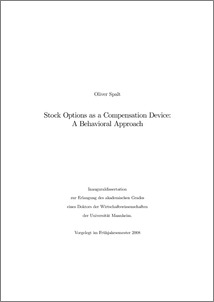|
Stock options as a compensation device: A behavioral approach
Spalt, Oliver
![[img]](https://madoc.bib.uni-mannheim.de/style/images/fileicons/application_pdf.png)  Vorschau |
|
PDF
Thesis_20080601_VersionDekanat.pdf
- Veröffentlichte Version
Download (1MB)
|
|
URL:
|
https://madoc.bib.uni-mannheim.de/2021
|
|
URN:
|
urn:nbn:de:bsz:180-madoc-20210
|
|
Dokumenttyp:
|
Dissertation
|
|
Erscheinungsjahr:
|
2008
|
|
Titel einer Zeitschrift oder einer Reihe:
|
None
|
|
Ort der Veröffentlichung:
|
Mannheim
|
|
Hochschule:
|
Universität Mannheim
|
|
Gutachter:
|
Maug, Ernst
|
|
Datum der mündl. Prüfung:
|
26 Juni 2008
|
|
Sprache der Veröffentlichung:
|
Englisch
|
|
Einrichtung:
|
Fakultät für Betriebswirtschaftslehre > ABWL u. Corporate Finance (Maug 2006-)
|
|
Fachgebiet:
|
330 Wirtschaft
|
|
Fachklassifikation:
|
JEL:
M52 , G30 , J33,
|
|
Normierte Schlagwörter (SWD):
|
Prospect-Theorie , Vergütung
|
|
Freie Schlagwörter (Deutsch):
|
Aktienoptionen
|
|
Freie Schlagwörter (Englisch):
|
Stock options , executive compensation , employee compensation , prospect theory
|
|
Abstract:
|
This dissertation analyzes existing managerial and employee compensation schemes in the light of recent advances in decision sciences and behavioral finance. In particular, I investigate what we can learn about the widespread use of stock options by incorporating prospect theory preferences into otherwise standard models – both theoretically and empirically. My results suggest that models in which agents have prospect theory preferences can rationalize the use of executive stock options, important features of stock option design, as well as the existence of broad based employee stock option plans in many companies. In Chapter 2, I propose a model which can rationalize the puzzling fact that stock options are frequently used as a compensation device for non-executive employees. I show that this can be attributed to the tendency of individuals to overweight small chances of large payoffs, which is modeled in prospect theory by the probability weighting function (a non-linear transformation of cumulative probabilities). Mine is one of the first models to demonstrate its potential usefulness in the corporate finance literature. The model is calibrated to a large US dataset over the years 1992 to 2005 and the predictions generated by the model are confirmed empirically. Chapter 3 proposes a model to explain the observed structure of CEO compensation and in particular the presence of stock options in almost all observed compensation contracts. Recent research indicates that the standard principal-agent model used in the literature (risk- and effort-averse CEO and log-normally distributed share-prices) cannot rationalize the presence of options (Dittmann and Maug, 2007). This chapter first theoretically derives optimal contracts when risk-averse agents in the model of Holmström (1979) are replaced by loss-averse agents. Optimal contracts combine punishment for extreme underperformance with high-powered incentives for share-price increases. In a second step, the model is calibrated for each CEO in a sample of 595 CEOs. The results in this chapter suggest that the loss-aversion model is a better paradigm for analyzing design features of stock options, and for developing preference-based valuation models, than the conventional model used in the literature. Chapter 4 analyzes the optimal design of executive stock options under the loss-aversion model. I find that benefits from corporate conformity or transaction costs are very likely to outweigh any savings to be obtained by individually adjusting strike prices to their optimal level. In addition, I find that firms with more powerful managers could save more by switching from observed contracts to predicted contracts. These findings are particularly important for the current debate in corporate governance regarding the relation between pay and performance since they show that there is a qualitative link between managerial power and contractual inefficiencies. I also show, however, that realizable savings would be tiny. Hence, there is little quantitative support for the managerial power view of executive pay from my analysis of the structure of compensation contracts.
|
|
Übersetzter Titel:
|
Aktienoptionen als Vergütungsinstrument: Ein behavioralistischer Ansatz
(Deutsch)
|
|
Übersetzung des Abstracts:
|
Diese Dissertation untersucht Aktienoptionen als Vergütungsinstrument für CEOs und Mitarbeiter. Es wird gezeigt, dass unter der Annahme, dass CEOs und Mitarbeiter Präferenzen im Sinne der Prospect Theory besitzen, beobachtete Vergütungsstrukturen effizient sein können. Im Speziellen wird herausgearbeitet, dass i) Mitarbeiteroptionen effizient sein können, wenn Mitarbeiter kleine Wahrscheinlichkeiten übergewichten (Kapitel 2), dass ii) die Vergütung von CEOs mit Aktienoptionen effizient ist wenn CEOs Verlustavers sind (Kapitel 3), und dass iii) die beobachtete Praxis, dass Optionen für CEOs am Geld vergeben werden, in einem Modell mit Verlustaversion erklärt werden kann (Kapitel 4). Alle Ergebnisse werden auf Basis von US Daten dokumentiert.
(Deutsch)
|
 | Dieser Eintrag ist Teil der Universitätsbibliographie. |
 | Das Dokument wird vom Publikationsserver der Universitätsbibliothek Mannheim bereitgestellt. |
 Suche Autoren in Suche Autoren in
Sie haben einen Fehler gefunden? Teilen Sie uns Ihren Korrekturwunsch bitte hier mit: E-Mail
Actions (login required)
 |
Eintrag anzeigen |
|
|
